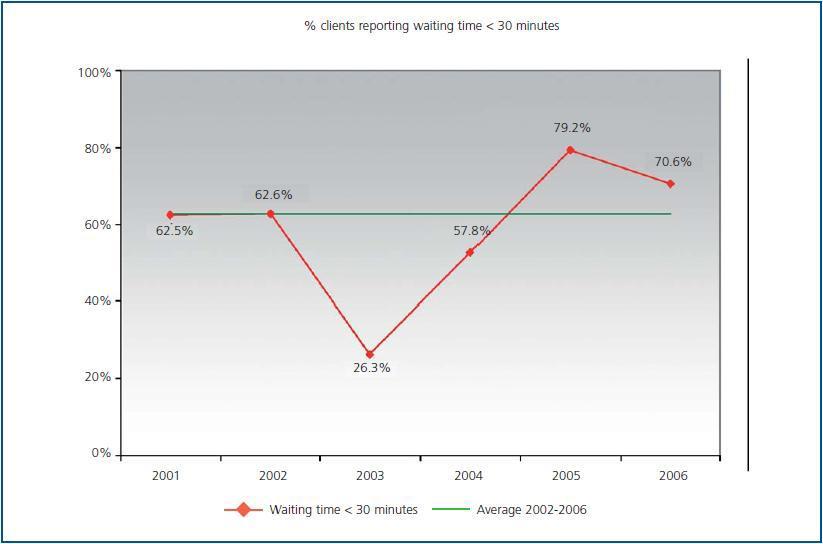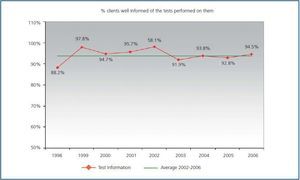En el año 1999 se constituye en el Hospital Clínic de Barcelona el Instituto de Nefro-Urología (ICNU), agrupación organizativa de los Servicios de Nefrología, Urología y Trasplante Renal. Al mismo tiempo, y con la finalidad de garantizar la política de calidad institucional en este proceso de cambio, se diseñó un programa de calidad específico, en el que se definían objetivos de mejora a conseguir en un año natural y se monitorizaban unas series de indicadores, tanto técnicos como percibidos para evaluar periódicamente su evolución. Los resultados de estos últimos cinco años indican que se ha observado una mejora en la mayoría de indicadores (exceptuando los relativos a las infecciones quirúrgicas y el tiempo de respuesta a las reclamaciones), contribuyendo a la consolidación y al reconocimiento de este proyecto innovador en la gestión asistencial de las enfermedades del sistema urinario que posiciona al enfermo en el epicentro de la organización, y reconoce a los profesionales sanitarios como verdaderos gestores del modelo.
The Clinic Institute of Nefro and Urology (ICNU) was formed in Clinic Hospital of Barcelona in 1999. It grouped together services of Nephrology, Urology and Renal Transplant. At the same time, in order to ensure Quality in this process of change, we designed a specific quality program. In this program, we defined objectives to improve the quality of these services in one year and we defined different quality indicators in order to maintain and monitor health quality. The indicators referred to technical quality and perceived quality and we periodically evaluated their evolution. The results of the last five years indicate that the majority of the indicators have improved, except those concerning infections surgery and the response to complaints. This has helped the consolidation and recognition of the work of this innovatory project in the health management of the nephrologic and urinary systems that locate the patient in the center of the organization and recognize the health professionals as the true managers of this model.
INTRODUCTION
In 1998, the Clinical University Hospital of Barcelona started a global and progressive internal reorganisation process, taking on a decentralised clinical management system based on grouping patients according to pathologies.
In July 1999, the Centre Medical Board approved the organisation proposal of the Clinical Institute of Nephrourology (ICNU), which encompasses the Departments of Nephrology, Urology and Kidney Transplant.
The Institute of Clinical Management ICNU started its trajectory, headed by an assistant director appointed by the managing director of the centre as proposed by the Institute’s Management Commission (Table 1). The heads of nursing and economic-administration will assist the assistant director in administrative task (Figure 1). The Institute has full administrative autonomy, managing a budget based on objectives that allow it, for example, to develop and establish innovative techniques and attract new clients.
One of the strategic objectives of the ICNU was the acquisition and development of a culture based on the continual improvement of its services which would contribute to a better knowledge of quality appraisal methods in the field of urinary system disease care.
The main aims of this study are to present the working dynamics established and to describe the changing outcomes resulting from this innovative programme of care management.
MATERIAL AND METHODS
The design of this project corresponds to a time series descriptive epidemiologic study carried out in the area of urinary system diseases at the Clinical University Hospital of Barcelona.
A specific and interdisciplinary task force was constituted. The different professional layers were represented from both the ICNU and the Institutional Quality Programme at the Centre. The technical and perceived quality indicators of interest were selected and a consensus was reached on the quality objectives considered most important for the political strategy of the Institute of Nephrourology. These objectives are evaluated and reconsidered annually.
It was unanimously agreed to identify at least one quality objective for each of the Departments that make up the Institute. Acknowledgement of these had to conform to the agreement between the Institute and Hospital Management. These should facilitate communication of the methodological standards for ongoing improvement among the Institute’s professionals. All those aspects in which a potential opportunity for improvement was evident were included.
The indicators used to monitor the basic dimensions of Quality1 were initially those defined by the Hospital Quality Plan (Tables 2 and 3). It was agreed that they would be expanded because new ones would be suggested or arise, according to the dynamics of the process.
The agreement of objectives is detailed in the quality report2 which assembles all of the information pertaining to quality evaluation at the Institute. The quality report is a vehicle of communication between the Institute and Management through which the change in objectives and indicators throughout the year are followed up.
RESULTS
Over the period in question, patient activity at the Institute increased in all its areas. Admissions varied from 2,386 in 2003 to 2,724 in 2007. The average stay improved from 6.82 to 6.5 days. The total number of outpatient visits increased from 21,362 to 25,909 (first visits went from 2,431 in year 2003 to 3,102 in 2007). An increase in the complexity of the pathologies treated was also observed as measured using the Average Relative Weight (ARW) of all the Diagnosis Related Groups (DRG) at the Institute. In 2003, this ARW was 1.32 as compared to 2.18 in 2007.
The development of the seven technical quality indicators monitored from 2003-2007 and that are considered as medical-surgical management variables are presented in Table 2.
Table 3 shows the progress of the five indicators of perceived quality for the same period of time for the different areas of activity of the ICNU.
Likewise, the objectives of quality improvement for both technical and perceived quality established by the Institute have been increasing over time. The initial objectives in 2003 were 9 and these progressed on to 16 agreed objectives in 2007.
DISCUSSION
Any organisational change carries the need for adaptation to a new reality by the professionals involved. Assuring that quality is not negatively influenced in this period and in subsequent stages is one of the basic tools for the consolidation of any organisational change.2,3
Redefining the care standards aimed at improving patient management and increasing overall efficiency of the organisation was carried out through the design and implementation of a series of Clinical Practice Guides. The majority of the professionals directly involved in treating patient care as set out in the protocol were involved in the development of the Guidelines.4
The results obtained show the success of the changes made. Acceptable standards have been consolidated and these have generated a positive working operation and a culture of ongoing improvement.
The necessary balance between average stay, readmissions under 31 days and the complexity of the patients treated, as well as their inter-relationship with other indicators all help to guide in the fulfilment of the social function intrinsic to any Clinical Management Institute5 which should also be taken into account in this context. Thus, the increase in surgical infection in 2007 can be explained in view of the parallel rise in complexity and expansion of complicated diagnostic-therapeutic interventions in ever older groups.
The programme also regularly monitors patient safety and records risks to which the patient may be exposed (surgical infection, bedsores and falls).6,7 The Institute actively participates and collaborates in noting the transcendental nature of these activities which are of institutional interest to the Hospital.
The patient as the true epicentre of the desired standards and his/her ever-increasing level of active participation in health matters reinforces the importance of knowing the patient’s point of view regarding the treatment he/she has received. Therefore, annual opinion surveys of hospitalised patients and out-patients8,9 are carried out. An assessment of the opinions collected also indicates the aspects to be improved and shows where the Institute is moving in the appropriate direction (Figures 2 and 3). The analysis of claims presented and their cost inclusion in the rate per patient activity performed (admissions plus outpatient visits) allows pinpointing of the problems and the subsequent proposal of improvement initiatives.10,11
Given the difficulty of having reference standards with which to compare our results,12 the development of the Institute’s indicators are analysed by comparing a year to the previous one and its evolutional tendency over the last five years. An internal reference standard is used (epidemiological average, obtained from cases presented over the past five years) (bold-type values in Tables 2 and 3). This reference value serves as an alert signal in the event that the data from the current year exceeds the usual reference value or even signals an unfavourable or negative development tendency.
Figure 1.
Table 1. Management Commission Structure
Table 2. Changes in technical quality indicators
Table 3. Changes in perceived quality indicators
Figure 2.
Figure 3.

















